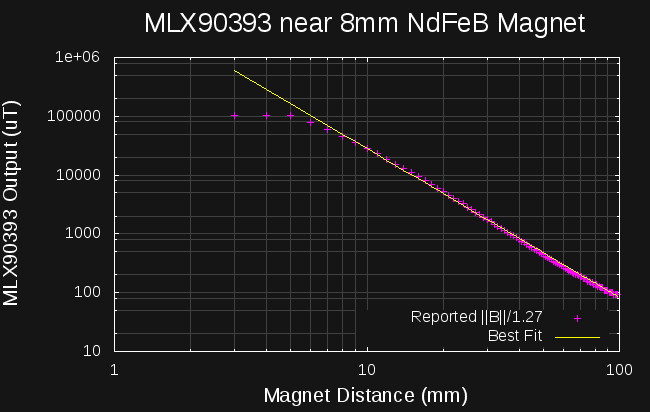I built a simple rig to test for magnetic saturation in the MLX90393 sensor. I happened to have a manual X-Y stage for macro photography, so I used it to move an 8mm NdFeB magnet (of strong but unknown field) near the sensor. Here's a picture of the apparatus:

The magnet was attached to the end of a 320mm wooden dowel with a length of heat-shrink tubing. The polyolefin tubing I used lists a shrink temperature of 125C, leaving a safe margin to the over 300C Curie temperature of NdFeB, so there's little chance of harming the magnet this way. The magnet/dowel assembly is then lashed to the X-Y stage to allow fine positioning of the magnet relative to the sensor.
I collected data from 3 to 98mm distance, recording a point every 1mm. The MLX90393 has GAIN_SEL=0 and RES=3, for a maximum full-scale range of 129184 μT according to the datasheet. After applying my empirically determined scale-factor of 1/1.27, this comes out to a little over 100 mT full-scale. The datasheet also states that the sensor starts to enter saturation (i.e. deviation from linearity) at around 50 mT. Here's the data I collected:

The data points are magenta; the yellow is a best-fit line to extrapolate the true field for small distances. Magnetic fields around a dipole drop off with an inverse power law, the exponent being 2 in the near field, and 3 in the far field. The regressed line here has a slope of -2.53, which seems plausible. The interesting thing about this line is that it shows an extrapolated field strength of approximately 0.6 T at 3mm. Sintered NdFeB magnets have a field strength of between 1.0-1.4T, so this seems reasonable. The MLX90393 output saturates at around 100mT (the full-scale value), and as noted in the datasheet, starts to deviate significantly from linearity at around 50mT.
I'm quite impressed with this sensor! These results would indicate that you could scan to within 6mm or so of the strongest magnets available, and still collect usable data. Closer than that, and the output would saturate, but this is easily detected and flagged in a visualization. I've selected a sensor: time to start designing a tiny board to carry it.
Next Up
I still haven't determined where the 1/1.27 scale factor comes from - I'm going to continue thinking about that. The Melexis web site is back up, and I downloaded their app note about temperature compensation; I should be able to add that to the driver soon. I'm also going to mount this sensor in a 3D printer and get back to what this project is supposed to be about - scanning some fields.
 Ted Yapo
Ted Yapo
Discussions
Become a Hackaday.io Member
Create an account to leave a comment. Already have an account? Log In.
Thanks a lot for the detailed measurements!
I am watching this as well... !
Are you sure? yes | no
I'm glad you're interested...I'm getting diverted into messing with stuff that I figured would "just work," but that makes for an interesting project, I guess :-)
Are you sure? yes | no
Great work! I'm watching this closely, while also being poor at updating the low field MRI build log...
Are you sure? yes | no
Thanks! I'm glad you set me back on the right track about strong fields and saturated sensors. Also glad the MLX part does the sane thing in such fields.
Are you sure? yes | no